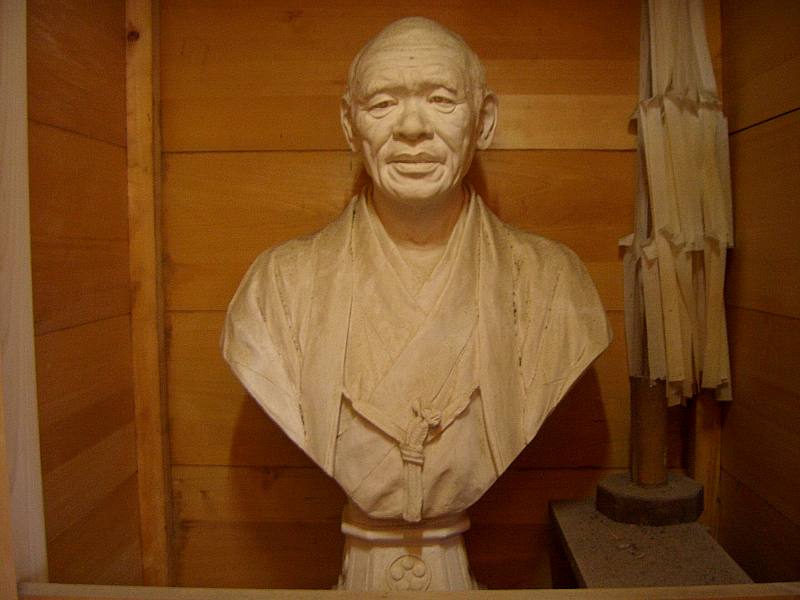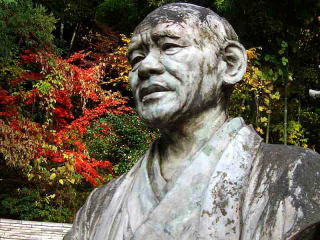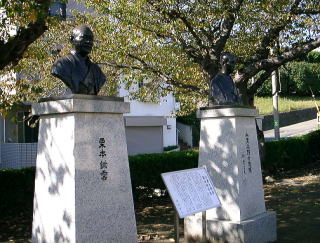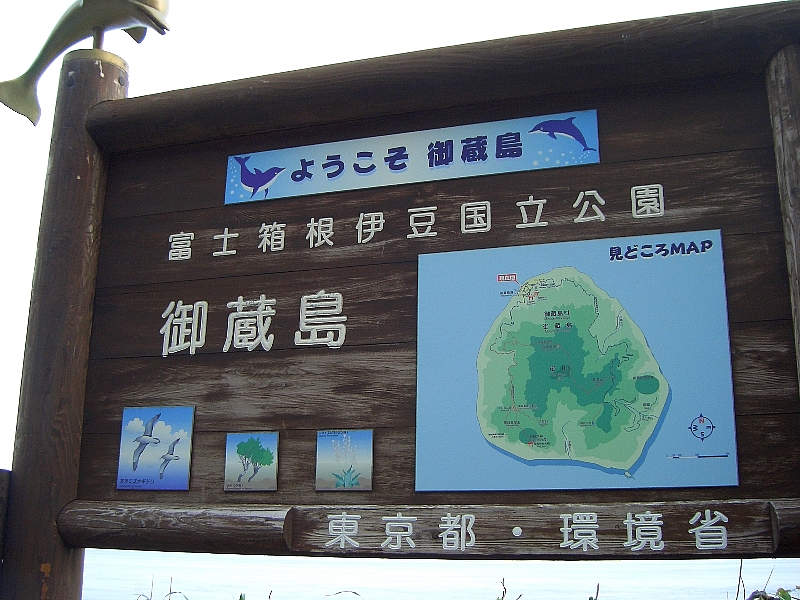| 御蔵島へ入る |
Visting Mikurajima |
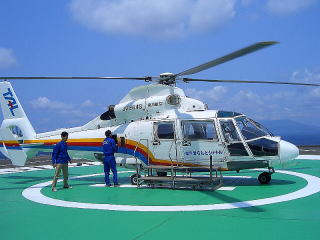 |
| ヘリは9人乗り 八丈島から北へ戻るように飛んで、たちまち御蔵島の海岸が見えてくる。 |
|
The helicopter carried nine passengers. We flew back north from Hachijojima,
and soon the coast of Mikurajima came into view. |
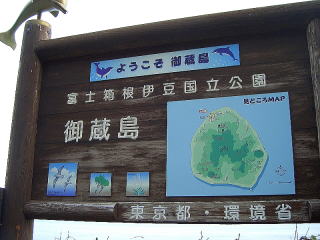 |
| 羽田~八丈島へ飛び、八丈島でヘリコプターに乗る前に計量。 荷物は一人5キロまで 全員パス |
We flew from Haneda to Hachijojima by airplane and we weighed our luggage
before boarding the helicopter at Hachijojima. Everyone passed the check.
|
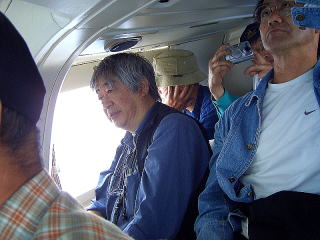 |
| 途中、足元の海に黒い塊がいくつも見える、あとでそれが黒潮だと聞いてナットクした。 |
| On the way, we saw a number of black masses in the sea below, which we
were later told was the Kuroshio Current. |
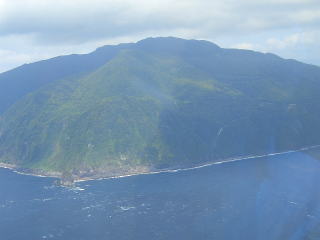 |
| お椀を伏せたような島、という形容にふさわしく、周囲は太平洋の荒波に削られ、切り立った断崖が囲む。 |
| The island, which is aptly described as a bowl-shaped island, is surrounded by sheer cliffs carved by the rough waves of the Pacific Ocean. |
 |
東京から南へ200キロ
役場前のテラスのように張り出したヘリポートに着陸した。前方は三宅島 |
| Two hundred kilometers south of Tokyo: We landed at the helipad that stretched
out like a terrace in front of the town hall. In the foreground is Miyakejima
island. |
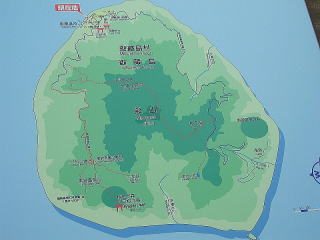 |
御蔵島
人口280人前後 もとは火山で出来た島だが、有史以来噴火の記録はない。古くは縄文遺跡の土器が出土し、江戸期には流人も送られてきた歴史がある。 |
| Mikurajima: The island was originally formed by a volcano, but there has been no record of an eruption since prehistoric times. Pottery from Jomon ruins has been unearthed here in the past, and exiles were sent here in the Edo period. |
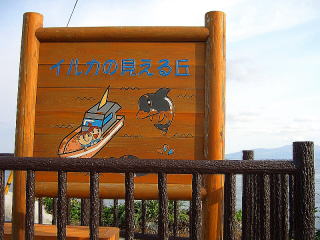 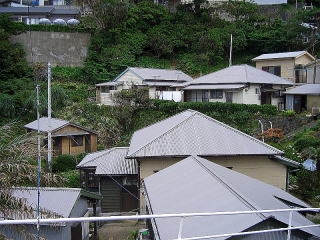 |
| 現在は、たくさんの若者がイルカウオッチングに訪れ、また島に残る自然や巨樹を探訪するトレッキングでも知られて、春から秋までのシーズン、狭い島が活気に満ちる。 |
| Nowadays, many young people visit the island to watch dolphins, and it
is also known for trekking to explore the island's nature and giant trees. |
◇島への渡航
①定期船が毎日夜東京竹芝桟橋を出航、朝三宅島~御蔵島~八丈島へと運んでくれる。
②飛行機で羽田~八丈島~ヘリで~御蔵島
*注意:宿の予約をしてない人は島に上陸滞在できない。(小さい島で荒天が続くと食料危機が起きる)
|
How to get to the island:
(1) Scheduled boats depart from Takeshiba Pier in Tokyo every evening and
take you to Miyakejima, Mikurajima, and Hachijojima in the morning.
(2) You can fly by plane from Haneda to Hachijojima, and then to Mikurajima
by helicopter.
Note: If you haven't made a reservation for accommodation, you can't land
or stay on the island (It's a small island, and if the stormy weather continues,
there will be a food crisis). |
| 栗本鋤雲(石膏)像 |
Statue of Joun Kurimoto (plaster) |
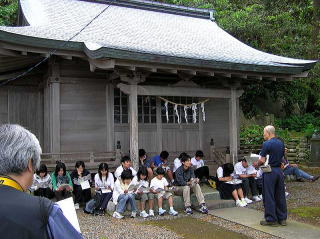 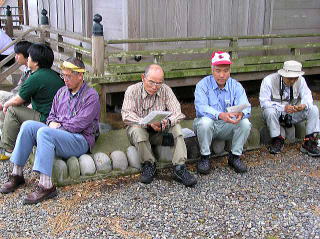 |
祖霊社前で栗本鋤雲の講話
栗本鋤雲(石膏)像がこのお堂の中に納められている
祖霊社の境内で、御蔵島小中学校の生徒と先生が「栗本鋤雲と島と小栗上野介」の話を聴いてくれた。ここはもと浄土宗万蔵寺が明治以後の廃仏棄釈で祖霊社というお堂となって残り、その奥の扉を開けると石膏像がしまわれていた。 |
Lecture on Joun Kurimoto in front of the Soreisha Shrine
A plaster statue of Joun Kurimoto is housed in this hall.
In the precincts of the Soreisha Shrine, students and teachers from Mikurajima
Elementary and Junior High Schools listened to my lecture on "Joun
Kurimoto, the Island, and Kozukenosuke Oguri."
This was the former Manzoji Temple of the Jodo sect of Buddhism, which
was abandoned in the movement of Haibutsu kishaku (of abolishing Buddhism
and destroying Shākyamuni) after the Meiji era (1868-1912). It then became
a hall called the Soreisha (Ancestral) Shrine, where we found the plaster
statue stored when we opened the door inside. |
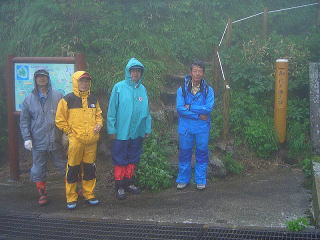 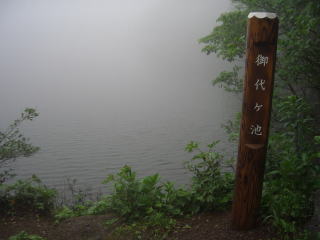
|
左:御代が池入口▲
栗本鋤雲は島に来た客が退屈しないようにと自宅の池の鯉を島に贈った。船で運び、小舟で島に上げて、どうやってここまで運んだのだろう。案内してくれた一郎さんは「中学生のころ釣りに来た」と語る。
右:少し登って急に下り▲
霧が深くて写真にならない。
あきらめていると、霧の中でバシャンと魚のはねる音がした。たしかに鯉がいる!
|
(Left) Entrance to Miyogaike Pond
Joun Kurimoto sent carp from a pond at his house in Tokyo to the island
to keep visitors to the island occupied. I wonder how they got carp up here at such a high elevation, even though they were able to transport them by boat and land them on
the island by small boat. Ichiro-san, who showed us around, said, "I
came here for fishing when I was in junior high school.
(Right) There were a short climb and a steep descent. The fog was too deep
to take pictures. As I was giving it up, I heard the sound of fish splashing
in the fog. There were indeed carp! |
御代(みよ)が池
鋤雲は島人の相談に応じて、暮らし向きがよくなる手立てをあれこれ考え援助を惜しまなかった。その素地は箱館時代の鋤雲の活躍にうかがうことができる。そして自邸の池の鯉を与え、島の御代が池に放流させた。今もその鯉が代々生き続けている。また養嗣子秀二郎は、経営する病院から島へ医師を派遣し続けた。洋館の診療所が祖霊社の隣にあり、三宅島や遠く伊豆大島からも診察を受けに来たという。
|
Miyogaike Pond
Joun consulted with the islanders and helped them think of ways to improve their lives. This can be seen in Joun's activities during the Hakodate period. He sent carp in the pond at his residence to the islanders, who released
them in the Miyogaike Pond.
Even today, those carp continue to live from generation to generation.
His adopted son, Shujiro, also continued to send doctors to the island
from the hospital he ran in Tokyo. There was a clinic in a western-style
building next to the Soreisha Shrine, and even people from Miyakejima and
as far away as Izu Oshima came to the island to receive medical examination. |
|
| ヴァイキング号漂着 |
American Ship "the Viking" Adrift |
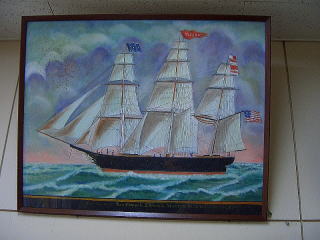 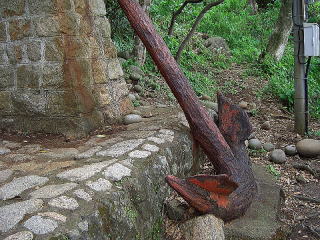
|
左:ヴァイキング号(1400㌧)
1863文久三年六月四日、難破して御蔵島に漂着。アメリカへ運ぶ途中の乗組員23人、雇用の中国人460人を全員無事に島人が救出している。 絵は島の教育長室で撮影
右:イカリ
稲根神社に残されている。大小二つあったという。保存の手立てをしないと、潮風で錆び痩せてゆき、消滅する恐れがある。 |
(Left) American Commercial Ship "the Viking" (1400 metric tons): On June 4, 1863 (Bunkyu 3), the Viking was shipwrecked
and drifted to Mikurajima Island. The islanders rescued all 23 crew members
and 460 Chinese employed by the ship on their way to America. The picture was taken in the office of the island's director of education.
(Right) Anchor: Remains at Inane Shrine. There were two of them, one large and one small. If thay don't do something to preserve them, they will rust and lose their shape due to the sea wind, and may disappear. |
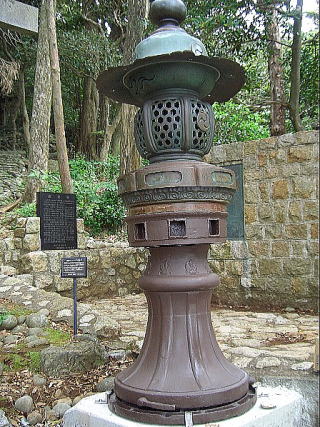 
|
左: 燈籠 稲根神社境内
台座をよく見ると四角い穴がいくつもある。バイキング号のキャプスタンcapstanを利用したもの。(穴に棒を差し込んで数人で回し、錨を巻き上げる)
右:高橋基生博士顕彰碑
稲根神社境内 ヴァイキング号の歴史を世に出したこと、御蔵島が亜熱帯地域でありながら北アルプスに見られる植物もあるなど、貴重な植物相の島であることを調査発表して、島の人々に大きな影響を与えた。 |
(Left) Lantern in the precincts of Inane Shrine: If you look closely at the base, you can see a number of square holes.
They are made from the capstan of the Viking (Sticks are inserted into
the holes and several people turn it to wind up the anchor).
(Right) Monument in honor of Dr. Motoo Takahashi: The monument is in the precincts of Inane Shrine. Dr. Takahashi had a great
influence on the people of the island by publishing the history of the
Viking, and by researching and publishing the fact that Mikurajima is a
subtropical island with valuable flora, including plants found in the Northern
Alps. |
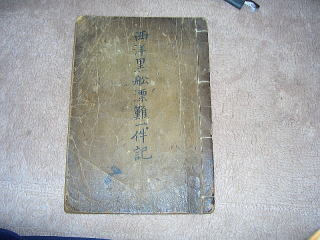 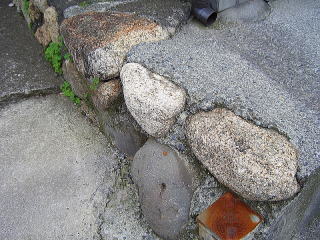 |
左:「西洋黒船漂難一件記」
当時31歳だった島の書役栗本市郎左衛門(のち一郎)が、米船の乗組員や乗客救出の先頭に立って処理し、後に事実をまとめた貴重な記録
◆近刊で『西洋黒船漂着一件記』高橋基生・ノーベル書房・昭和44年 /小林亥一『文久三年御蔵島英単語帳』平成10年・小学館 がある
右:バイキング号の歴史発見のキッカケはこの石
民家の石垣に御蔵島にはないはずの花崗岩に気づいた高橋博士は、島の伝承からバイキング号の歴史を掘り起こした。石はバイキング号の船底のウェイト(重り)だった。
戦後、米軍が御蔵島を空爆の演習地(全員立ち退きで射的の島)に計画した時、米国船員救出の島の歴史をアメリカ市民に訴えた。アメリカ側の事情も変化してこの計画は中止となった。 |
(Left) A Chronicle of the Drifting Western Black Ship
Ichirozaemon (later Ichiro) Kurimoto, who was 31
years old at the time, took the lead in rescuing the crew and
passengers of the U.S. ship, and later compiled the facts into a
valuable record.
Recent publications about the ship are "Seiyo Kurofune Hyochaku Ikkenki"
(Motoo Takahashi, Nobel Shobo, 1969) and "Bunkyu 3 Mikurajima Eitangocho"
(Iichi Kobayashi, 1998, Shogakukan).
(Right) This stone is the key to the discovery of the history of the Viking
Dr.
Takahashi noticed granite on the stone wall of a private house, which
should not be found on Mikurajima, and dug up the history of the
Viking from the island's folklore. The stone was used as a weight for
the bottom of the Viking.
After the second world war, the U.S. military once planned to turn Mikurajima
into a training ground for air strikes by forcing all the islanders to
evacuate, but Dr. Takahashi appealed to American citizens about the island's
history of rescuing American sailors. As a result, the plan was canceled,
while also circumstances on the U.S. side was changing. |
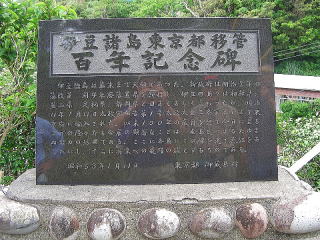 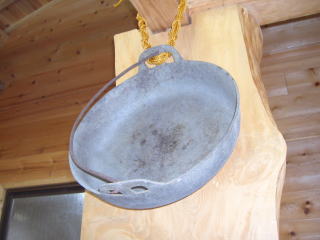 |
左:東京都移管100年記念碑
幕末まで天領だった伊豆諸島が、韮山県管轄を経て明治11年以来の東京都移管100年を記念する碑 昭和53年
右:おいしかった!
「美美庵・みんみんあん」のホウロクヤキの元祖焙烙ホウロクが柱に吊るしてありました。
お宿にしかわでは、食べきれないほどの魚尽くし。 |
(Left) Monument commemorating the 100th anniversary of the transfer of
the Izu Islands to the Tokyo Metropolitan Government: Before the transfer, all the Izu Islands including Mikurajima were directly
controlled by the Shogunate until the end of the Edo period. The monument
was erected in 1978.
(Right) It was delicious!
The original HOROKU (earthenware baking pan) was hung on a pillar at Mimmin-an food shop which sells HOROKU-YAKI confectionery. At the inn Nishikawa, they served delicious fish more than we could eat. |
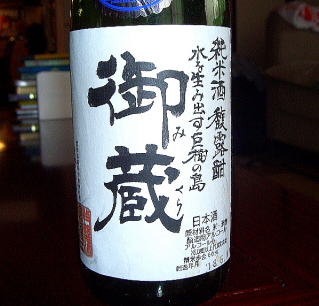 |
純米酒・純米吟醸酒
水を生み出す巨樹の島
御蔵(みくら)
初めて訪ねる御蔵島。どんな酒が飲めるか気がかりで、特製ラベル「御蔵」を考えて手書きデザインし、牧野酒造で「馥露酣」に貼り付けてもらって、「馥露酣の御蔵島バージョン」として前もって宿「にしかわ」に1ケース送っておいた。
宿でおかみさんに持込料がわりに一本上げたら、「アラ、おいしい!」
オヤジさんも気に入って「西川商店」で売りたい、と我々が飲んでる最中に牧野酒造に電話して、商談成立。
今では島の酒として認知され、いい酒は冷やして飲むが普通になった
群馬県内でも入手困難な銘酒「馥露酣・ふくろかん」が御蔵島で飲める.
「にしかわ」商店で買えます
|
Junmaishu and Junmai Ginjoshu (sake made without added alcohol or sugar and sake brewed by low temperature
fermentation from white rice milled to 60% without added alcohol or sugar)
An island of giant trees that produce water
Mikura
This was my first visit to Mikurajima Island. I was anxious to see what
kind of sake I would be able to drink, so I came up with a special label
"Mikura," designed it by hand, had it pasted on the "Fukurokan"
sake brand at Makino Shuzo brewery, and sent a case of the "Mikurajima
version of Fukurokan" to the Nishikawa Inn in advance.
At the inn, I gave a bottle to the inkeeper's wife in lieu of a carry-on
fee, and she said, "Oh, it's delicious!"
The inkeeper liked it too and wanted to sell it at Nishikawa Store, so
he called Makino Shuzo while we were drinking, and a deal was made.
It is now recognized as the sake of the island, and it is common to drink
good sake chilled.
You can drink Fukurokan sake, that is hard to find even in Gunma Prefecture, in Mikurajima.
You can buy it at the Nishikawa Store on the island.
|
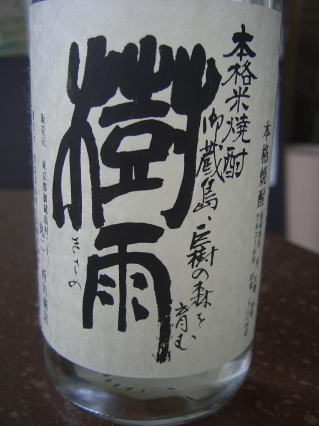 |
本格米焼酎
御蔵島、巨樹の森を育む
樹雨(きさめ)・
牧野酒造の本格焼酎が島の酒として発売になりました
「にしかわ」商店で買えます
❏樹雨とは…島にぶつかった気流が山に沿って上昇し霧となって木の枝葉からしたたり、御蔵島を豊かな水と巨木の島に育てている。枝葉から降る雨だから「樹雨」
:命名者は平岡忠夫(全国巨樹巨木林の会・奥多摩)・ラベルの書は村上泰賢 |
Authentic Rice Shochu
Mikurajima, nurturing forests of giant trees
Kisame
Makino Shuzo's authentic syochu liqueur is now on sale as the island's
sake!
You can buy it at the Nishikawa Store.
What is KISAME?
The air currents that hit the island rise along the mountains and form
a mist that drips from the branches and leaves of the trees, making Mikurajima
an island of abundant water and giant trees. The rain that falls from the
branches and leaves is called "kisame," which means "rain
dripping from trees."
Named by Tadao Hiraoka (Okutama, Japan Association of Giant Tree Forests),
label written by Taiken Murakami. |
|
